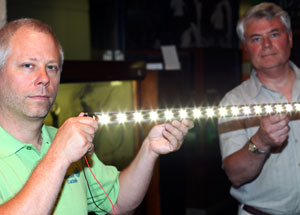 |
| Johnson Controls' Peter Cherry and Alan Yeadon, regional manager with HD Supply/Litemor. (Bruce Bottomley Photo) |
Dalhousie’s Life Sciences Centre has been a fixture on Studley campus since 1971 and people have never stopped scratching their heads about it. To say the least, its design is controversial. But a great deal of that controversy concerns its notoriously dark interior.
Prepare to pack away your torches, ladies and gentlemen, because times are a-changing; the LSC is getting new lights.
Johnson Controls specializes in maximizing building efficiency. The company was hired last June to assist Dal with the LSC retrofit – a major upgrade to the building’s electrical, heating, ventilation and air conditioning systems predicted to reduce Dal’s carbon emissions by 6,000 tonnes annually.
The electrical component of the upgrade includes a sweeping overhaul of the outdated and inadequate lighting scheme, currently under way with a projected cost of approximately $3 million.
“Back in the initial design in the early 1970s, the wrong fixtures were used in the building and the positioning of the fixture was wrong in most cases,” explains Alan Yeadon, regional manager for HD Supply/Litemor. Mr. Yeadon’s company is responsible in cooperation with Johnson Controls for design, site coordination and supply for the lighting retrofit.
Peter Cherry is a professional engineer and solutions account executive with Johnson Controls. “A lot of times you just end up shaking your head as to why something was done a particular way,” he says about the old lighting system.
Some of the LSC’s original 40 year-old lights have very low efficiency ratings, making for dark spaces. Consider that today’s LSC could also be nearly 30 per cent darker than when it first opened because of depreciation of the fixtures.
Big improvement
Many new fixtures are up and operating now in hallways, labs and classrooms and people are noticing a huge improvement in atmosphere.
New fixtures in secondary hallways will be equipped with motion sensors on 20-minute delays. “In the evenings when the traffic is low, you’ll enter a space and the light will immediately go up to the high level,” says Mr. Cherry. “If you enter a space and the (light) level is up, you know somebody else is there. So there’s a bit of security and safety there.”
Retrofit measures will cut energy consumption while increasing light levels throughout the building to meet Illumination Engineering Society international standards. Total electricity savings is projected to be 1.3 million kWh annually and that translates to approximately $150,000.
While 70 per cent of lighting costs go to energy consumption, the remaining 30 per cent is for labour – maintenance and materials costs, which is also a big ticket item for a building the size of the LSC.
Dalhousie covers a lot of ground. “The reality is, it’s a horizontal facility,” Mr. Yeadon explains. “It’s around 38 minutes on average to change a light bulb.”
Johnson Controls and HD Supply/Litemor have calculated the lighting retrofit will yield labour savings of approximately $160,000 per year. Add that to the electricity savings and the lighting retrofit will save Dal over $300,000 annually.
Lighting technology has changed a lot in 40 years, even in the last four months.
Efficient LED bulbs
Incandescent bulbs last about 1,000 hours and spiral compact fluorescents 10,000. It’s believed new LED bulbs being used in the LSC will last between 25,000 and 50,000 hours. The technology is so new that experts can’t yet say how long the bulbs will last, but at only 2.5 watts each the LED bulbs are a welcome change.
Once all retrofit work is complete, officials hope the LSC will be certified through the Leadership in Energy and Environmental Design (LEED) system for existing building operation and maintenance.
“It is strongly related to operating and how you do your renovation and how you do your cleaning... and all these different things,” says Mr. Cherry. “Your building needs to consume only a certain amount of energy… (and) the lighting will really help.
“To take this building that was finished in (1971) and attain LEED certification for it will be a huge accomplishment.”
